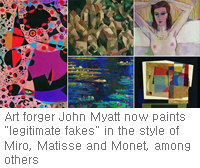짝퉁이 더 좋아
By Melissa Hogenboom
Can you love a fake piece of art?

A court battle is fought over whether a painting is fake, a drawing said to be Warhol is disputed, but is there ever a case for cherishing the fake and the forged?
Wrong signature. Dubious provenance. Fake. These are words an auction house dreads to hear.
This is exactly what happened recently with a drawing hailed as an early Andy Warhol. It was denounced by his brother as a fake but discussions on its authenticity are ongoing.
A work by Van Gogh or Munch can fetch tens of millions. Cast a shadow of doubt over its provenance and that value rapidly declines.
But if it has a level of draughtsmanship, colour and imagination that is nearly enough to fool an auction house expert, isn't that worth something?
Han van Meegeren is a candidate for the greatest forger ever. The Dutchman came closest to being acclaimed as an artist in his own right after gaining notoriety forging 17th Century Dutch masters that would fool art-loving Nazis.
While his own paintings were of little interest to critics, his forgeries earned millions and conned, among others, Hitler's deputy Hermann Goering.
Van Meegeren was arrested in 1945 and charged with treason for selling a Vermeer - classified as a Dutch national treasure - to the Nazis. Facing a possible death penalty, he confessed all - that he was a forger.
The Dutch authorities didn't believe him. To prove he was no traitor, he was asked to paint a copy.
"A copy," Van Meegeren is reported to have exclaimed, "I'll do better than that. Give me the materials and I will paint another Vermeer before witnesses."
Before the war, frustrated that his style of painting did not suit the world's new-found interest in modern art, Van Meegeren had forged a Vermeer in his own style that was "unlike any previous Vermeer", says Frank Wynne, who wrote a biography of the forger.
"What infuriated him was a skill that would have made him famous in an earlier age was of no interest to anyone at a time when the world was interested in post-impressionism."
His experiment worked. His painting, The Supper at Emmaus, was hailed as a previously unknown masterpiece by Vermeer and was one of the most visited paintings in the Netherlands until it was revealed to be a fake.
Van Meegeren wanted to prove that a famous signature on a painting hugely influences how beautiful we think it is, says Wynne.
"A famous artist's signature gives us the romantic notion that their paintings are sacred artefacts that were touched by the hand of a genius."
Van Meegeren's work has since come to be appreciated in its own right.
He has even inspired other forgers to fake his work, an example of which was recently presented to the BBC's Antiques Roadshow, and valued at only £200 to £300.
Convicted forger John Myatt has had a little of the same recognition. He was arrested in 1995 for fraudulently selling around 200 paintings in the style of modern masters.
He claimed he didn't initially set out to dupe art collectors, but after a fake sold at auction for £25,000, his collaborator John Drew offered him half the cash in a brown envelope. A partnership of crime had begun.
Myatt painted fresh works in the style of famous modern artists while Drew created false paper trails, showing previous supposed sales.
It was - according to Scotland Yard - the start of "the biggest art fraud of the 20th Century".
Myatt was convicted for conspiracy to defraud, and spent four months in Brixton prison. He now legitimately sells his paintings in the style of famous artists, with "genuine fakes" written on the back. But he believes 120 of his illegal forgeries are still in circulation.
Like Van Meegeren, Myatt does not simply copy famous works. His paintings are entirely new, but in the style of a master. He says he "climbs into their minds and lives" and searches for the inspiration behind their work.
Later this year he has an exhibition in his own name and says people seem to be "fascinated by fake paintings".
"There can be quite a lot of demand from people who can't afford a Van Gogh but are looking for the same aesthetic experience for a fraction of the price."
Pretentious critics and the "disgusting amounts" of money changing hands can leave people feeling alienated by the art world, he adds.
"People also like the idea that experts are fallible and make mistakes."
